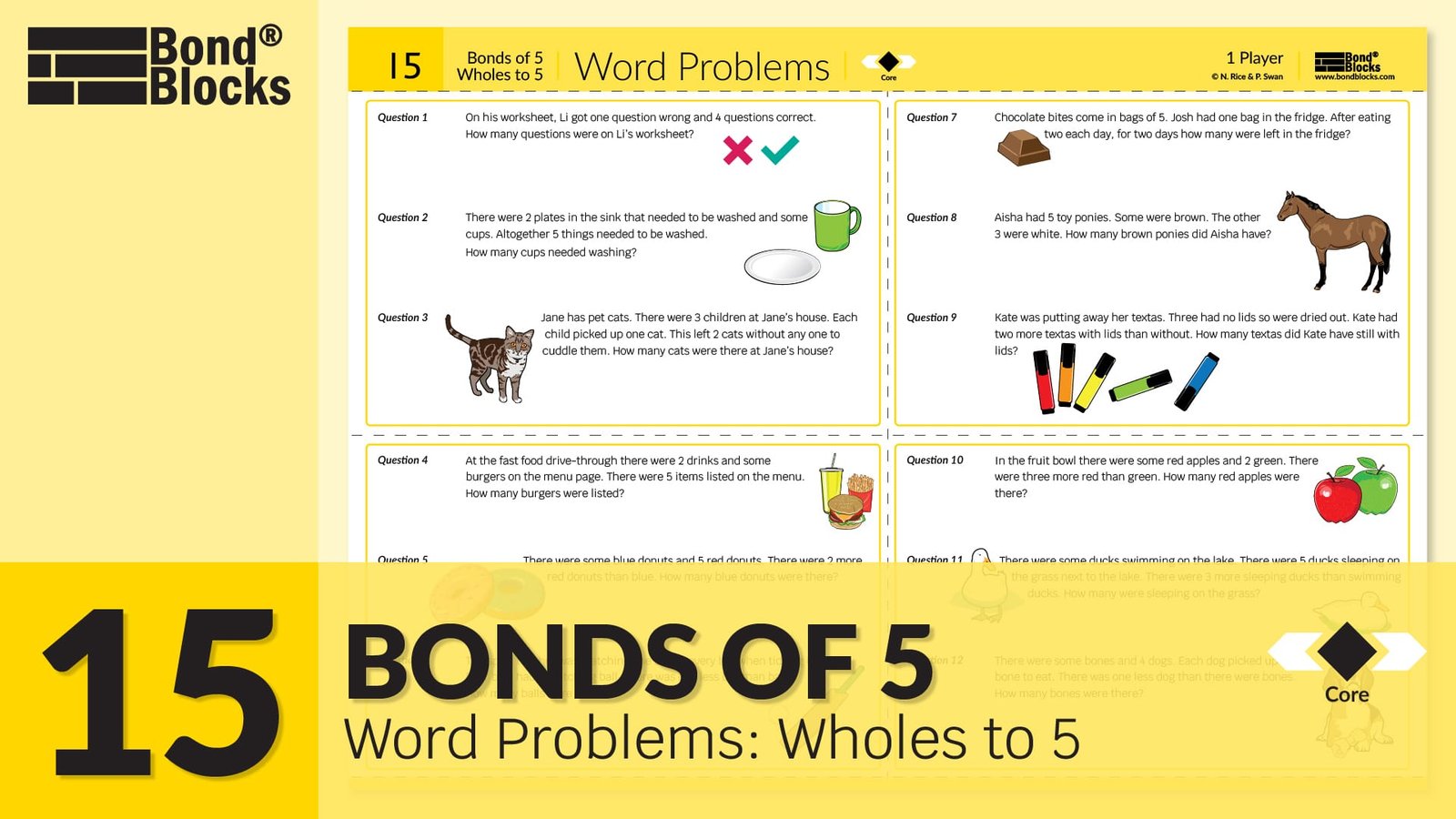15) Word Problems
Bonds of 5: Wholes to 5

Mathematics
Apply the concept of part-part-whole and fluency recalling bonds, of wholes up to and including five, to solve addition and subtraction word problems.
The problem types are varied. The missing number is in a range of different positions.
Language
Click this link to read Teacher Notes for more information about mathematical language related to “Solving Word Problems”. These notes outline the benefits of using a using a diagrammatic approach and caution against linking key words to specific operation.
Core Activity
Aim
To solve word problems.
Materials
An activity for individual students sitting in pairs.
Each student needs a pencil and paper.
Each pair needs:
- One Bonds of 5: Word Problems Wholes to 5 card containing three questions.
- Access to one set of Bond Blocks.
Instructions
Cut the Bonds of 5: Word Problem activity board into 4 cards.
- Each card contains three word problems. Within each card the questions increase in difficulty.
- Each card also increases in difficulty. Questions 1 to 3 are easier than Questions 10 to 12.
- Every card contains a range of addition and subtraction problem types for a variety of wholes up to and including 5.
Give each pair of students one problem solving card and set of blocks. Students can work independently or collaboratively. Students use Bond Blocks to support problem solving and calculation only if needed.
Many problems can be solved using a variety of calculation strategies. For example, 5 – ? = 3 can be solved by adding onto the known part (3 + ? = 5) or rearranging the subtraction (5 – 3 = ?).
At the conclusion of the lesson select one problem. Instruct students to compare strategies used to:
- Solve the problem. Encourage students to identify new ways of solving problems.
- Calculate. When comparing strategies used, ask students to explain why different addition and subtraction strategies can both produce correct answers. Encourage students to identify efficient calculating strategies and justify their reasons. Examples of different solutions for each question are provided in the Bonds of 5: Word Problem Answers.
Click to open the Bonds of 5 Word Problem Answers in a new tab.

Differentiation
A little easier
Polya’s problem solving process
Assist students who are experiencing difficulty by identifying the part of the problem solving process, as outlined by Polya, they need help with.
Refer to page 4 onwards of the Teacher Notes “Solving Word Problems” for more information about using Polya’s Problem Solving Process and specific strategies, including Newman analysis, to support students who are experiencing difficulty.

Click to download this poster of Polya’s Problem Solving Process.
Scaffold support
Scaffold the type of support given to students using the Concrete-Representational-Abstract framework.
- If students are experiencing difficulty at the abstract level using numbers and symbols ask them to represent the problem using Bond Blocks.
- If they have difficulty at the representative level using Bond Blocks ask them to use concrete materials or drawings with one-to-one correspondence.
Word problems with diagrams
Click to open the Bonds of 5 Word Problems with Diagrams in a new tab.
A little harder
Questions 10 to 12
Each card increases in difficulty. The final three questions are the most difficult.
Activity 40 Bonds of 6,7,8,9: Word Problems Wholes to 10
Typically students solve problems that use numbers that are slightly less than they calculate with fluently because of the complexity of the problem solving process. If students have completed up to Activity 39 Bonds of 6,7,8,9: Missing number Equations they can solve word problems using Activity 40 Bonds of 6,7,8,9: Word Problems wholes to 10.
Progression
The next chapter of activities focuses on initial double bonds that can be represented using the student’s two hands. The sequence of activities is similar to the Bonds of 5 chapter moving from identify bonds, to developing fluency, then calculating. Go to
Activity 16
Doubling and Halving to 10: Bonds, Building a Wall
